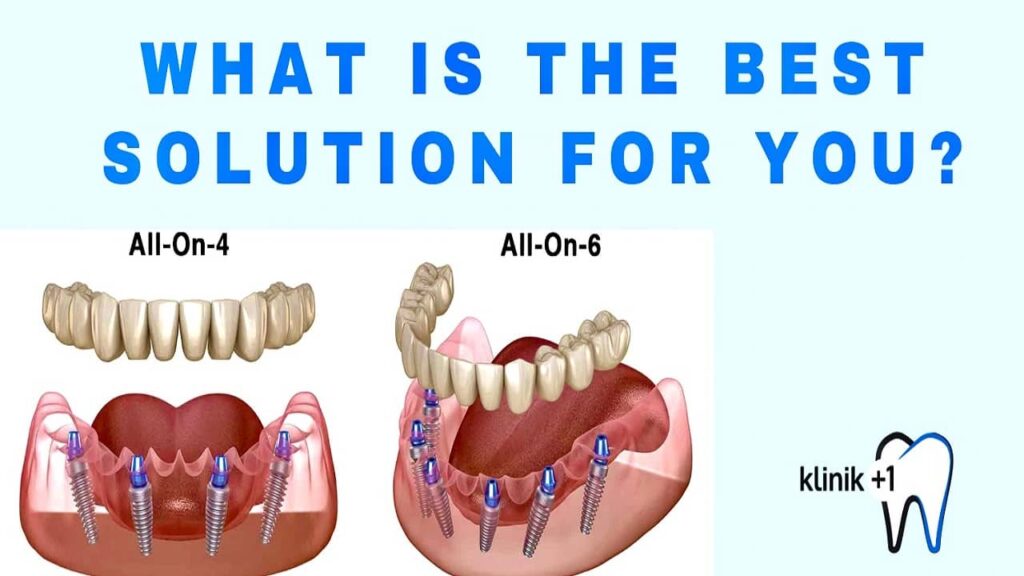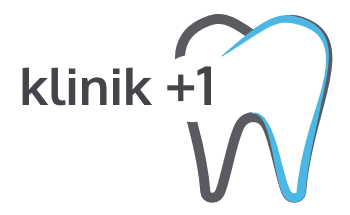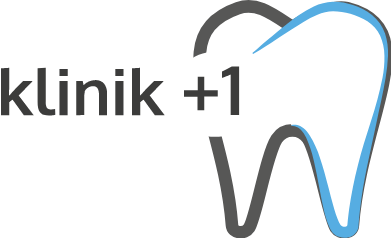All On Four All On Six
welcome to
Klinik +1 Dental Clinic
All-On-Four and All-On-Six are two popular options to restore your smile. Both procedures involve the use of dental implants and a prosthesis to create a full arch of teeth.

All-On-Four vs All-On-Six: Discover The Best Option For You
All-On-Four and All-On-Six are two popular options to restore your smile. Both procedures involve the use of dental implants and a prosthesis to create a full arch of teeth. But which one is the best option for you? This article will provide a comprehensive comparison of All-On-Four and All-On-Six, highlighting their differences and benefits. By the end of this article, you will have a better understanding of which option is ideal for your specific needs.
Key Takeaways
• All-On-Four uses four dental implants, while All-On-Six uses six.
• All-On-Four and All-On-Six are dental solutions that utilize dental implants and a prosthesis to restore a full arch of teeth.
• The number of dental implants used can affect the stability and success rate of the procedure.
• Consulting with a dental professional is crucial to determine the best option for your individual needs.
All-On-Four Dental Solution
If you’re missing a full arch of teeth, the All-On-Four dental solution may be the answer to restoring your smile. This solution involves the use of dental implants and a prosthesis to create a functional and aesthetically pleasing set of teeth.
The All-On-Four solution typically involves the placement of four dental implants in the jawbone. These implants serve as a secure foundation for a custom-made prosthesis, which is attached to the implants to create a full arch of teeth.
One of the main benefits of All-On-Four is its ability to provide improved functionality compared to traditional dentures. With All-On-Four, you can enjoy eating your favorite foods without worrying about your teeth slipping or coming loose.
Additionally, All-On-Four can provide a more natural-looking smile, as the prosthesis is custom-designed to match the shape and color of your natural teeth. This can improve your overall self-confidence and quality of life.
How All-On-Four Works
The All-On-Four procedure typically involves the following steps:
1. Consultation with a dental professional to determine if All-On-Four is the best option for you
2. Jawbone assessment to ensure there is enough bone density to support the implants
3. Placement of the dental implants into the jawbone
4. Attachment of a temporary prosthesis to the implants while they heal
5. Final placement of the custom-made prosthesis once the implants have fully integrated with the bone
It’s important to note that All-On-Four requires proper post-operative care to ensure long-term success. Your dental professional will provide instructions on how to properly care for your new teeth and implants to ensure they last as long as possible.
Exploring All-On-Six Dental Solution
If you’re considering a dental solution to restore your smile, All-On-Six is another option to consider. This solution uses six dental implants to support a prosthesis, compared to the four used in All-On-Four. The additional implants provide extra stability and support, making All-On-Six a great option for those with a stronger jawbone and more complex dental needs.
All-On-Six is a permanent solution that can improve both the functionality and appearance of your smile. The procedure involves the placement of six dental implants, which serve as anchors for a prosthesis. This prosthesis is designed to look and function like natural teeth, providing a long-term solution for missing teeth.
One of the benefits of All-On-Six is that it allows for immediate function. After the procedure, you’ll be able to use your new teeth right away. This is because the six implants provide enough support for the prosthesis, allowing it to withstand normal biting and chewing.
Overall, the choice between All-On-Four and All-On-Six depends on individual factors such as jawbone strength and dental needs. Consulting with a dental professional can help you determine which option will work best for you.
Comparing All-On-Four and All-On-Six
When considering dental solutions such as All-On-Four and All-On-Six, it’s essential to compare the pros and cons of each option to make an informed decision. Here’s a detailed comparison:
All-On-Four | All-On-Six | |
Number of dental implants | Four | Six |
Bone density requirements | Low to medium | Medium to high |
Treatment time | Shorter | Longer |
Success rates | High | Also high |
Pros | • Less invasive than traditional implants • Shorter treatment time • Lower bone density requirements | • Increased stability and support • Can be suitable for higher bone density • Can be used in cases of bone grafting |
Cons | • Limited to certain cases • Not suitable for everyone • Requires a higher degree of precision | • Longer treatment time • Higher bone density requirements • More invasive than All-On-Four |
When considering which dental solution is best for you, it’s critical to take into account several factors. While All-On-Four may be the best option for those in need of a quick solution with lower bone density requirements, All-On-Six may be the better choice for those who need more support and have higher bone density. The decision ultimately depends on your case-specific needs and preferences.
Procedure Details for All-On-Four
The All-On-Four procedure involves four dental implants being placed in the jawbone to support a full arch of teeth. The procedure typically begins with a consultation to determine if the patient is a good candidate for the treatment. During this consultation, a dentist will examine the patient’s teeth and jawbone to assess their suitability for the procedure.
If the patient is deemed a good candidate, the next step is to create a personalized treatment plan. This may involve taking x-rays or taking impressions of the patient’s mouth to create a model of their teeth.
The dentist will use this model to create a custom-made prosthesis that will attach to the implants. During the procedure, the four dental implants will be placed in the jawbone and allowed to fuse with the bone over several months. Temporary prostheses will be attached to the implants to provide support and allow the patient to function normally while the implants heal.
Once the healing process is complete, the temporary prostheses will be removed and replaced with the permanent prosthesis. The final prosthesis is designed to look and function like natural teeth, offering a long-lasting solution for patients with missing teeth or severe dental issues.
Procedure Details for All-On-Six
The All-On-Six dental solution is similar to All-On-Four in terms of its use of dental implants and prosthesis to restore a full arch of teeth. However, as the name suggests, All-On-Six uses six dental implants instead of four for added stability and support. The first step in the All-On-Six procedure is the initial consultation, during which your dental professional will assess your jawbone density and overall oral health. If you are a suitable candidate, the dental implants will be surgically placed into your jawbone in a pattern that allows for optimal support of the prosthesis.
Once the dental implants are in place, a temporary prosthesis will be fitted to your mouth to provide you with functional teeth while you heal. After a period of around six months, during which the implants fuse with your jawbone through a process called osseointegration, the final prosthesis will be attached. This will be custom-made to match the size, shape and colour of your natural teeth for a seamless and aesthetically pleasing result.
It is worth noting that the All-On-Six procedure generally requires a higher level of bone density than All-On-Four due to the increased number of implants. Your dental professional will be able to advise you if you are a suitable candidate for this procedure based on your individual circumstances. Post-operative care is also vital for the success of the All-On-Six procedure. You will need to maintain good oral hygiene by brushing and flossing regularly, and attend regular check-ups with your dental professional to monitor the health of your implants and prosthesis.
Conclusion
Now that you have a better understanding of All-On-Four and All-On-Six dental solutions, you can make an informed decision on which option is best for you. It’s important to remember that everyone’s dental needs are different, so always consult with a dental professional before making a final decision.
Both All-On-Four and All-On-Six have proven to be successful methods for restoring a full arch of teeth. All-On-Four uses four dental implants, while All-On-Six utilizes six, and both come with their own unique benefits and drawbacks.
Factors such as bone density requirements and treatment time should be considered when making a decision. Understanding the procedures for each option can also help in making a decision. Remember, proper oral hygiene and regular dental visits are essential to maintain your new smile. Your dental professional will provide you with all post-operative care instructions to ensure your new teeth last a lifetime.
FAQ
A: All-On-Four and All-On-Six are both dental solutions for restoring a full arch of teeth. The main difference lies in the number of dental implants used – All-On-Four uses four implants, while All-On-Six uses six implants.
A: All-On-Six provides increased stability and support due to the use of six dental implants. This can be beneficial for individuals with weaker jawbones or who require more support for their prostheses.
A: All-On-Four offers improved functionality and aesthetics by replacing an entire arch of teeth with a prosthesis supported by just four dental implants. It is a minimally invasive procedure with a shorter treatment time compared to other options.
A: All-On-Six provides increased stability and support due to the use of six dental implants. This option may be more suitable for individuals with weaker jawbones or who require more support for their prostheses.
A: When comparing these options, it’s important to consider factors such as success rates, bone density requirements, and treatment time. Consultation with a dental professional is crucial in determining the best option for your specific needs.
A: The All-On-Four procedure typically involves a series of appointments, including an initial consultation, implant placement, and the final placement of the prosthesis. The exact timeline can vary depending on individual circumstances.
A: The procedure for All-On-Six is similar to All-On-Four, but with the placement of six dental implants instead of four. The timeline and specific steps may vary depending on individual needs and the recommendations of the dental professional.

